When I was young, my parents took me on the 'Liverpool Electrics'. The rolling stock was the L.M.S. built electric trains introduced in 1938 which looked very modern to my eyes. Eventually, British Railways classed these electrics as Class 502 and Class 503. Although vehicles survive in preservation, all the trains in service are now Class 507 and Class 508.
After many changes, the extended system now operates as Merseyrail and their website is here. There's also a Wikipedia article here.
Merseyrail's Wirral Line incorporates the Mersey Railway which built the first Mersey Tunnel and opened using steam traction in 1886. In 1903, the Mersey Railway was electrified. There's a little more in the post Early Days of the Mersey Railway.
Exploring the Merseyrail Network
A number of earlier posts have chronicled my recent travels on the third rail electrified Merseyrail network.
The first post was Day Trip to Liverpool in 2010.
More journeys were described in By rail to Liverpool (Part 2)
- (Part 1 described the first part of my journey that day on Network Rail).
More travel followed, described in Birkenhead and New Brighton by train (Part 1) and Birkenhead and New Brighton by train (Part 3).
- (Part 2 describes a walk around Birkenhead Docks.
The post Railways around Birkenhead has further information on Birkenhead's railways.
On Saturday 4th October 2014, having earlier travelled on most of the former Cheshire Lines Committee (CLC) routes which still have a passenger service (as described in the post here), I transferred to the Northern Line of Merseyrail to explore the short section of the former CLC line from Hunts Cross to Liverpool. Later, I used the Wirral Line from James Street to West Kirby and back and finally travelled to Ellesmere Port.
Hunts Cross - Sandhills
I joined the Merseyrail system at Liverpool South Parkway and decided to first travel to Hunts Cross, the limit of Merseyrail operations, and take a few pictures. The picture below is a general view of Hunts Cross station from island platform 2/3, looking towards Liverpool. The CLC provided an impressive brick station building on the Down side which is now licensed premises called 'The waiting room' (with the definite article alone capitalised).
 Hunts Cross, looking towards Liverpool, showing the former CLC main lines.
Hunts Cross, looking towards Liverpool, showing the former CLC main lines.
 Looking towards Liverpool from platform 3 at Hunts Cross. Platform 3 is third-rail electrified for terminating Merseyrail trains.
Looking towards Liverpool from platform 3 at Hunts Cross. Platform 3 is third-rail electrified for terminating Merseyrail trains.
After a very hasty survey, I re-boarded the train I'd arrived on, now heading for Southport, and travelled on the 'last bit' of the CLC to Liverpool. The area around the modern Brunswick station appeared to be a retail park - I'll have to go back to see if any parts of the early railway infrastructure remain. Now the CLC Liverpool terminus has gone, the line descends in a tunnel to the modern sub-surface Liverpool Central before continuing to Moorfields, near the original Lancashire and Yorkshire Railway terminus at Liverpool Exchange. The train then climbs the Great Howard Street Incline to reach the 22 spans of the Great Howard Street Viaduct and the 68 spans of the Liverpool Exchange Viaduct which formerly carried the approach tracks to Liverpool Exchange.
I alighted at Sandhills station and, on the landward side of the station, immediately came to a modern industrial estate built on the site of the former CLC Huskisson Goods Depot. The aerial view of Sandhills below, taken in 1937, suggests how completely the area has changed. The Lancashire and Yorkshire lines from Liverpool Exchange appear centre left and divide near the top of the picture, curving left to Bank Hall for Southport and carrying straight on to Kirkdale for Aintree and beyond.

Sandhills in 1937: The sidings bottom left form the 'throat' of the CLC Huskisson Goods Depot. The road running horizontally near the bottom left is Sandhills Lane (Click on the image for a slightly larger version).
One of the 'units' on the industrial estate which occupies the site of the CLC Huskisson Goods Depot houses the Sandhills Area Signalling Control (ASC) which manages most of the Merseyrail network. This is an Integrated Electronic Control Centre (IECC).
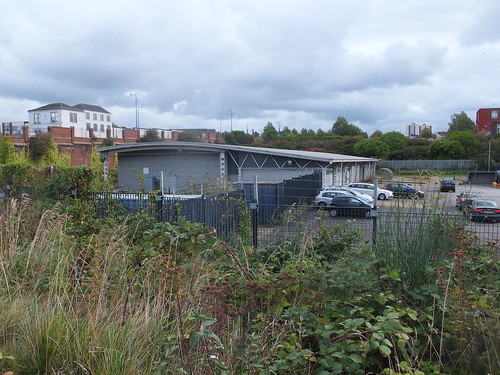 Sandhills Area Signalling Control: The road at high level in the background is Sandhills Lane and the now white painted buildings can also be seen on the 1937 photograph above.
Sandhills Area Signalling Control: The road at high level in the background is Sandhills Lane and the now white painted buildings can also be seen on the 1937 photograph above.
I then set off towards the river along Sandhills Lane so as to join Regent Road (the main dock road) and walk back towards the city, in order to see the Regent Road Scherzer Rolling Lift Bridge. This walk in described in the post On foot around Liverpool Docks. My walk ended at James Street Merseyrail Station, on the Wirral Line, where I caught a train towards West Kirby.
James Street - West Kirby
James Street station was built on the double-track Mersey railway between the railway tunnel under the Mersey and the terminus at Liverpool Central (Low Level). With the building of the balloon-shaped Liverpool Loop by British Railways, a new platform was built on the new alignment for trains approaching Liverpool. Having traversed the Loop, trains now heading for the Wirral still call at the original Mersey Railway platform, which has been modernised to match the other underground stations. The original Liverpool-bound platform still exists, in a largely un-modernised form, and now serves as a link-line between the Wirral Line and the Northern Line for rolling stock transfer. So passengers waiting for Wirral Line trains face the now-unused platform which conjures up a good idea of the station before the construction of the Liverpool Loop, indeed, it's evocative of the steam days. There's a brief description of the early days of the Mersey Railway here. The steps of the overbridge linking the two original platforms (not now in use) still proudly carries the cast builder's plate marked 'Manufactured by the Butterley Company 1885'.
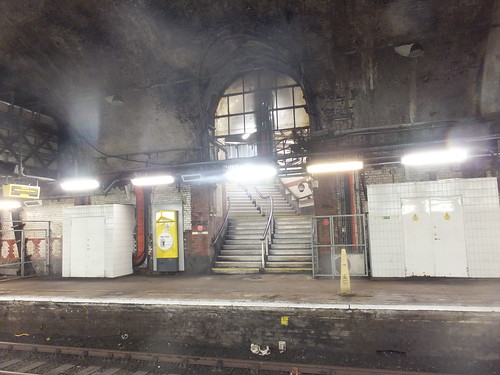 The largely un-modernised now-unused platform at James Street.
The largely un-modernised now-unused platform at James Street.
I discovered that Hamilton Square Station (at the Birkenhead end of the river tunnel) had closed a few days earlier for a period of around six months for re-furbishment. During the closure, a Rail Replacement bus service loops between Hamilton Square Station, Birkenhead Central Station, Conway Park Station then back to Hamilton Square Station. I didn't want to catch a Chester or Ellesmere Port train as that would have involved a bus transfer from Birkenhead Central to Conway Park but the first train to arrive was for New Brighton, allowing me to travel on it and change anywhere up to Bidston.
I decided to change at Birkenhead Park. This is now just a simple island platform with access from a road overbridge carrying Duke Street (further north, Duke Street is carried over the Great Float of the docks on a Scherzer Rolling Lift Bridge as I described in the post here). Originally, the Mersey Railway terminated at Birkenhead Park making an end-on connection with the Wirral Railway. There were four platforms and it must have been busy with every train terminating and reversing. The Mersey railway was electrified in 1903 but the Wirral Railway remained steam hauled until 1938 when, at last, the whole network was electrified by the LMS. There are clues to the station's former importance - extra arches on the road bridge and a too-wide formation where there were once additional tracks. As elsewhere where redundant tracks are 'lifted', a small forest is appearing.

Birkenhead Park, looking towards Hamilton Square with a Liverpool-bound train in the distance, showing its ugly station building on Duke Street.
After a few minutes, a West Kirby train arrived and I hopped aboard to complete my journey to the terminus.
 View from the island platform at West Kirby, looking towards Bidston and Birkenhead.
View from the island platform at West Kirby, looking towards Bidston and Birkenhead.
The small town of West Kirby (the population was less than 8,000 around the year 2001) looked quite attractive in the morning sun. I walked towards the promenade which looks out across the Dee Estuary. There's a Marine Lake which was being used by windsurfers. At low tide, it is possible to walk to the Hilbre Islands - a walk of about two miles each way. There were quite of few groups of walkers making their way to the islands but I had other plans and returned to the railway station, pausing to take tea and a toasted tea-cake in the cafe 'Toast' which forms part of the attractive station buildings.
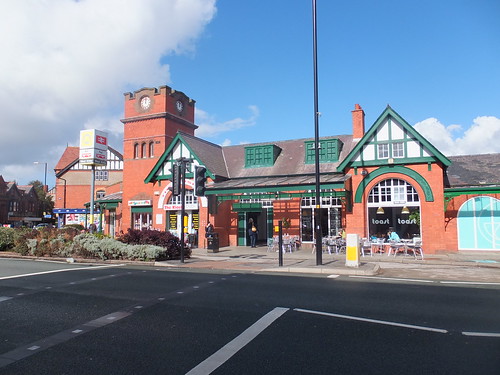 West Kirby Station from the road.
West Kirby Station from the road.
My plan was then to travel to Ellesmere Port, so I boarded the next departure - quite busy with Liverpool-bound shoppers. Normally, I would have changed for an Ellesmere Port train at Hamilton Square but, because of the refurbishment, I crossed under the river again and changed at James Street.
James Street - Ellesmere Port
The first train was for Chester but I decided to board this as far as Birkenhead Central, giving me an opportunity to look around the station, and then take an Ellesmere Port train. The station is above ground and, despite various additions and alterations (invariably unhelpful), still has a 'flavour' of the original.
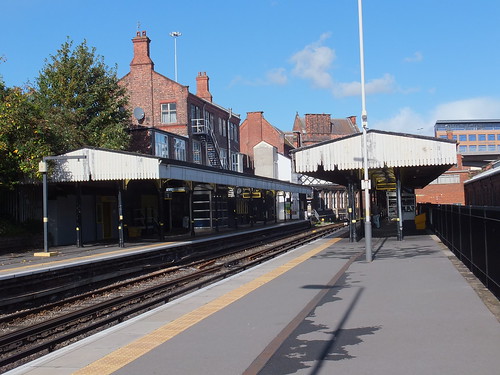 General view of Birkenhead Central, looking towards Hamilton Square and Liverpool.
General view of Birkenhead Central, looking towards Hamilton Square and Liverpool.
I caught the Ellesmere Port train which took the route I'm now familiar with to Hooton, where it turned left onto the double track to Ellesmere Port. There were some fairly major earthworks, where cuttings had been hewn through the sandstone, bringing us to Little Sutton, with an attractive stone-built station building on the Down side.
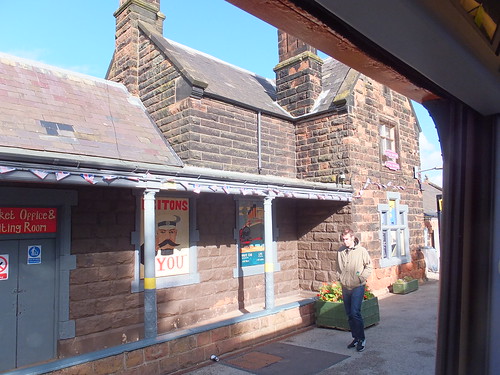 Little Sutton Station: Stone building on Down Platform.
Little Sutton Station: Stone building on Down Platform.
We had one more stop at Overpool and arrived at our destination, Ellesmere Port. However, the double track line continues beyond the station, though operated by Northern Rail, not Merseyrail (and not electrified). I left the station and walked towards the National Waterways Museum but found the roundabout leading to the M53 very unfriendly to pedestrians so, intending to go forward by a Northern Rail train, I returned to the station.
 Ellesmere Port station. Merseyrail electrics use the far platform (platform 1); Northern Rail trains use the near platform.
Ellesmere Port station. Merseyrail electrics use the far platform (platform 1); Northern Rail trains use the near platform.
Merseyrail trains arrive in platform 1 on the down line and, when unloading and loading has taken place and the Driver and Guard have changed ends, the train departs via a trailing crossover to reach the Up line for the journey back to Hooton.
 Ellesmere Port: View from platform 1 looking towards Hooton.
Ellesmere Port: View from platform 1 looking towards Hooton.
My journey onward from Ellesmere Port is described in the post Ellesmere Port - Helsby line.
My pictures
Merseyrail.
Ellesmere Port - Helsby line
